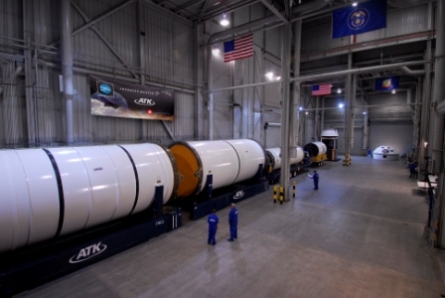Space Shuttle solid rocket booster provider Alliant Techsystems has released information and images of its proposed launcher for space services company PlanetSpace's Commercial Orbital Transportation Services (COTS) demonstration programme bid, after PlanetSpace was selected as a finalist by NASA for the agency's $175 million COTS space act agreement, to be awarded in February.
The three-stage ATK COTS launcher consists of, a first-stage with a 2.5-segment derivative of the Space Shuttle’s 4-segment Reusable Solid Rocket Motor (RSRM); an ATK Castor 120, used on the Lockheed Martin Athena's I and II variants and Orbital Sciences Taurus launch vehicles, for its second-stage; an ATK Castor 30 third-stage; and an Orbit Adjust Module, which has been flown on the Athena. ATK has been developing the Castor 30 internally for the last two years.
|
|---|
Above: This image shows actual hardware at ATK's Promontory facility to show NASA the COTS launch vehicle propulsion elements exist and are flight proven |
"A big advantage of the design is that it's modular in nature. We can fly the entire vehicle for a COTS-class mission, or we can fly a smaller payload by flying all but the RSRM first stage. In fact, we already have three letters of intent from different customers for the small launch vehicle. We plan to fly the first small launch vehicle in September 2009, and launch our COTS demonstration vehicle in December 2010 [from Cape Canaveral]," says ATK advanced programmes' director, Joel Crook.
ATK claims that the performance capability for the initial COTS launch vehicle is nearly 25% greater for GTO missions and almost 40% better for TLI missions, compared to the heavy version of a Boeing Delta II.
The company also expects an additional 709kg of payload capability for ISS missions by incorporating composite case and solid propellant upgrades into the two-and-a-half segment first-stage. Its launches could also "serve as a flying testbed for potential Ares I [crew launch vehicle] and Ares V [cargo launch vehicle] booster upgrades", says ATK.
Source: FlightGlobal.com
























